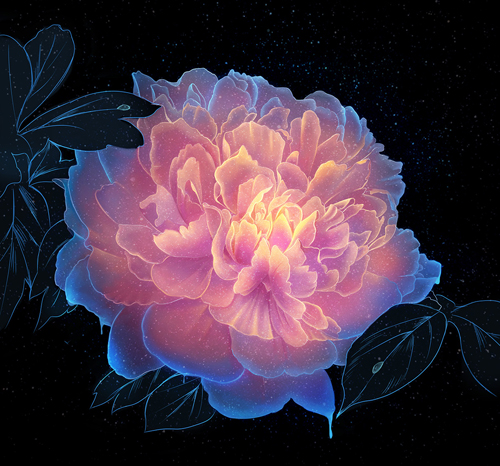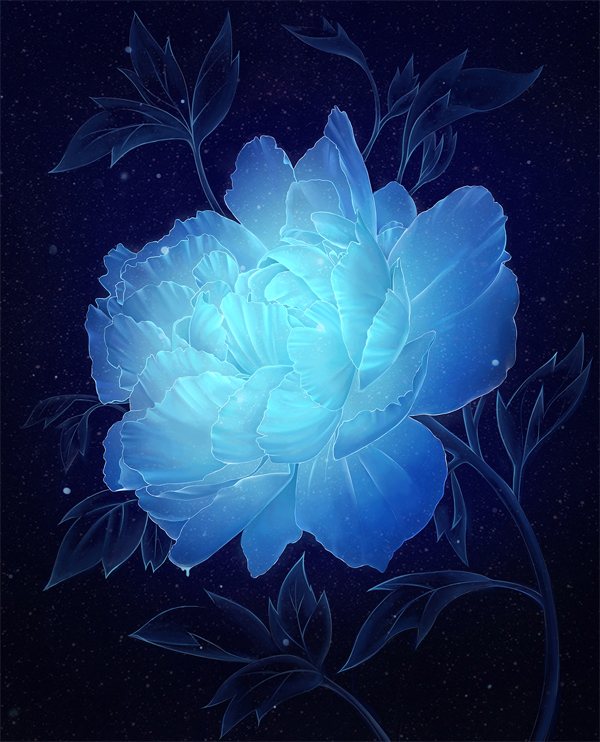The Phantom Blossom
Although the Phantom Blossom is not considered a rare plant, it's uncommon enough that some people might go their whole life without ever seeing one. They grow in small clusters, a handful of thin bushes with two or three flowers each, and can be found all throughout the Feywild.
The places where they bloom seem random at first thought, with no cause or reason. Phantom Blossoms have been found near rivers, inside caverns, up high in seemingly inhospitable mountains, in dark city streets, even near volcanoes. Their surrounding environment doesn't seem to affect them in any way, no matter the weather or circumstances, nor to be what causes their emergence. No, according to what people have been able to discern throughout millennia of research, the source of these clusters is something else entirely.
It is said - and some have insisted they have witnessed such a phenomenon - that when a ghost disappears from this world, a cluster of Blossoms appears in the place where they ceased to exist. But not every ghostly disappearance seems to cause these flowers to bloom - the ghost cannot have been killed or banished, nor can it be a specter, for the connections to their previous life are broken and shattered. It seems a new cluster is only born when everyone who remembered the ghost from when they were still alive has passed away, leaving them utterly alone. There is no one left to remember their name, their voice, who they were, what they did, how they died... and so those same traits and memories begin to dissipate in the ghost's mind. Their grief is so immense that they consume themselves, a flame burning away their ethereal bodies, and they disappear from this plane, leaving these flowers in their wake. Their unresolved business will forever remain unresolved, these ever-living flowers the only remnant that it ever existed, that this person ever walked the world.
It is not known why this happens to some ghosts, but not all. Some turn violent upon losing their memories and what anchored them to the material world, and go on violent rampages. Others give in to grief, to solitude, to an all-consuming sadness, and those seem to be the ones who are capable of leaving this peaceful, beautiful mark upon the world, although they'll never know it.
Basic Information
Genetics and Reproduction
If one attempts to cut a Phantom Blossom to replant it someplace else, the flower will immediately wither and die. There are no known ways of transplanting these clusters to another locale, because they are magically and spiritually linked to the place where they appeared, their roots going way beyond a purely physical connection to the ground which houses them.
Fortunately, these clusters are ever-living. If one flower is cut and it withers, the rest of the plant remains there, and the blossom will eventually come back, although it takes months for it to do so. The same happens if one attempts to remove the whole bush, or the whole cluster - all of it will wither, and it will take several months for it to begin to sprout back. The number of flowers in a cluster is always the same, alluding to some kind of symbolism or meaning behind this number.
Occasionally, very rarely, a new cluster will appear, if the right conditions are met. This happens only every once in a blue moon, and even then the cluster takes a while to grow and form its own blossoms, which keeps the number of existing Phantom Blossoms very low throughout time.
Biological Cycle
The Phantom Blossom has two phases: normally it is found in shades of blue, shimmering with a faint light. But occasionally its petals turn to tints of pink, orange, yellow, and red, as if a flame is contained within the flower itself. This is known as the cinder phase.
These changes are rare, and usually only last from a couple of hours up to a whole day. Their significance is unknown, but it is assumed that it's in some way related to the life, or death, of the ghost who faded away. Perhaps it's in remembrance of an important date or event, or, if we flip the coin, it is in mourning of something or someone long gone, lost to time immemorial. This theory seems to be supported by the nectar - or tears, as they have come to be called - that drips from the petals while this transformation lasts.
Additional Information
Uses, Products & Exploitation
The petals of the Phantom Blossom can be plucked and crushed to make tea with, which has light soporific effects. The process of drying them has to be done immediately after they're plucked, or they will wither and die. It's not commonly used this way, though, because although it does make people sleepy, it also tends to make them feel sad, lonely, and distressed for no apparent reason. In some occasions people will even have mildly disturbing hallucinations. Are these memories from another life, another mind, or simple hallucinations? Not enough people willingly drink this tea for there to be a definite conclusion.
The nectar from the cinder phase of these flowers, though, is extremely valuable. When re-purposed it's called Cinder Mist, and it's a powerful drug. It's usually mixed in with water, tea, or other beverages, and it has a sweetly cold aftertaste. Those who partake in it are able to sleep from six to eight hours straight, and almost nothing will be able to wake them up. Their dreams are filled with surreal and extremely realistic dreams which people are able to control with the appropriate amount of experience. Some use this opportunity to, in a way, keep planning and thinking and experimenting even while sleeping. Others simply want to explore fantastical worlds of their own creation, and live adventures they couldn't possibly go through in their normal day-to-day life.
It's not all a sea of roses, though - drink too much cinder mist and these dreams will instead turn into nightmares, and one's sleep will become restless, draining and exhausting. Cinder mist has been used to torture people in this way, or for people to take revenge upon someone who has wronged them. With a high enough concentration, it is even possible to trap someone in a nightmare world for quite a long time, keeping them a prisoner in their own mind.
It's hard to predict when the blossoms will change phase, so it's a difficult endeavor to be able to collect enough nectar for it to be harmful in this way, but it still happens - the Fey have more than enough time to dedicate part of their lives to this, if they have the patience for it. A lot of people will be looking for these tears - a handful of them might be enough for a pleasant sleep, but a lot more are needed for it to become toxic. Some camp out near known clusters as they wait for the blossoms to turn, while others travel between all the known cluster locations to be able to collect the nectar. It might take them a lot of time and effort, but the money one might be able to earn in the black market certainly makes it worth it. At least it will, if they're able to avoid other dealers, nymphs who protect these glades, or other nature-inclined Fey who think it absolutely blasphemous to use the Phantom Blossoms in this way.
Guardians
Some nymphs or nature-inclined Fey have taken upon themselves to protect these clusters. They think the Phantom Blossoms should be protected and maintained just as they are, to respect the ghost whom they represent, and should not be corrupted for other uses such as the drug cinder mist (more about this below), or disturbed in any other way.
Remove these ads. Join the Worldbuilders Guild











Comments